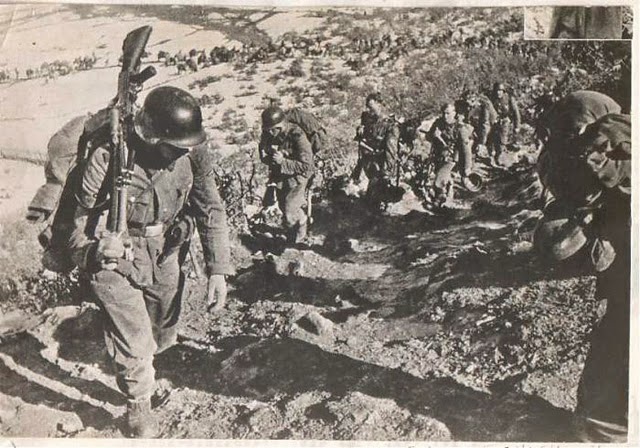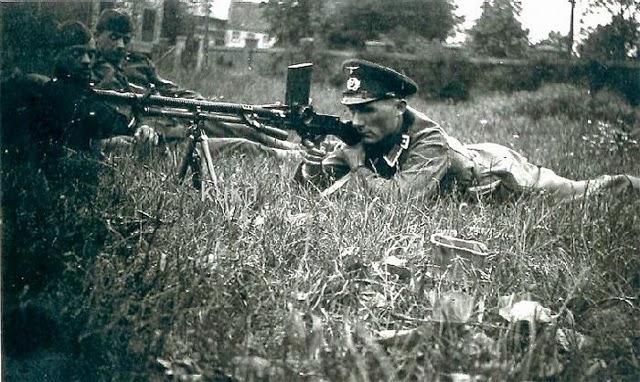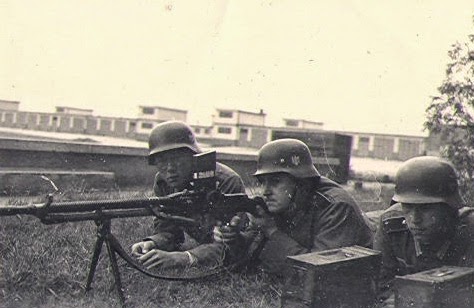General Historical Information
Uniform and equipment issue lists for soldiers in Landesschützen and Sicherung units
The Soldbuch was the standard identity document carried by every Wehrmacht soldier. Among the information recorded in this document was a complete list of uniform and equipment items, that the soldier was issued. This information is an extremely valuable resource for anyone trying to learn what was issued to soldiers in specific units, or types of units.
Gefreiter Josef Foschiatti was assigned to occupation duty in Norway with Festungs-Bataillon 655, Sicherungs-Bataillon 668, and Feldkommandantur 200. In his Soldbuch picture, which dates from 1943 or 1944, he wears an M36 tunic. His collar Litzen are improperly folded and crudely hand sewn with thick dark thread.
The uniform and equipment issue insert in his Soldbuch is very interesting. The “Tornister 34 m. Trager.” and “Tornister 39” are printed as separate items. Foschiatti had the 34 model, with integral shoulder straps, as late as April 1945. He also had 3 collar binds and 1 pair “Tragegurten” which I were the internal suspenders for the M36 and M40 model field blouse. He had jackboots. It is likely that this soldier in 1945 had what we might regard as an “early war” appearance.
His uniform and equipment issued by Sicherungszug 280 in April 1945:
1 field cap
1 field blouse
1 HBT jacket
1 pair wool pants
1 pair HBT pants
2 pair underwear
1 pair sports shorts
1 overcoat
1 Zwieback bag
3 collar binds
2 shirts
1 sweater (“Schlupfjacke 36”)
3 pairs socks, 1 pair foot wraps
1 pair jackboots
1 helmet
1 Tornister 34 with straps
1 pair slippers
1 butter dish
1 Zeltbahn and accessories
1 belt with buckle and bayonet frog
3 equipment straps
1 bread bag with strap
1 canteen with cup
2 mess kit straps
2 ammo pouches
1 mess kit
1 ID disk
2 hand towels
1 eating utensils
1 handkerchief
5 cleaning brushes
1 pair internal suspenders
1 sewing pouch
1 blanket
Foschiatti also had a rifle, a bayonet, an entrenching tool, a gas mask model 1930, a gas sheet, 4 Losantin containers, an RG34 rifle cleaning kit, and bandages- 1 large, 1 small.
Here is the uniform and equipment issue record for another soldier, Gefreiter Rudolf Mainz.
Mainz was issued the following while serving with Landesschützen-Btl. 442 on September 23, 1944:
2 field caps
1 field blouse
1 HBT uniform…
2 wool trousers
2 pair underwear
1 overcoat
2 collar binds
2 shirts
1 sweater
1 toque
1 pair gloves
1 pair leg warmers
1 pair socks
1 pair low boots
1 Waffenrock
1 helmet
1 rucksack
1 belt
3 equipment straps
1 bread bag without strap
1 canteen
1 ammo pouch
1 hand towel
2 handkerchiefs
1 pair suspenders
1 ID disk
3 pairs shoulder board unit slip-ons
He also got a captured French rifle and bayonet on the same date. Specifically, a Berthier Mle 1907/1915.
Internal suspender retaining hooks on German Army M36 and M40 field blouses
Every factory made enlisted issue M36 and M40 field blouse was lined in such a way to accommodate the internal suspenders that held the belt hooks in place. Part of this system was two small wire hooks sewn into the field blouse liner, below the belt hook eyelets on each side. These hooks retained the ends of the internal suspenders. There were no corresponding retaining hooks below the rear belt hook eyelets.
A small sample of original enlisted issue M36 and M40 field blouses was examined to determine what types of suspender retaining hooks were used and how they were positioned.
“Der Winteranzug der deutschen Soldaten”
The Winter Clothing of the German Soldier
by Oberfeldzahlmeister Wortmann
published in “Deutsche Uniformen-Zeitschrift”, February 1944
Translated by Chris Pittman
The winter of 1941/42 showed that our German winter clothing, built for central European conditions, does not measure up to eastern European degrees of cold. Through the unparalleled donation by the German people of fur and wool items, the troops in winter 1941/42 were provided with the necessary additional cold protection. The donations were even so generous that considerable surplus remained, which was professionally stored and partially reworked, and made usable for the troops for the next year. Additionally, the clothing that had been worn in the winter was collected again in Spring 1942 and prepared with much care for the winter of 1942/43- disinfected, cleaned, repaired.
This stock of winter uniforms formed a foundation that could be built on, but in no way did it achieve an adequate supply for our troops deployed in the East in winter 1942/43. Totally new clothing, suitable for the eastern European winter, had to be developed. For this, the experiences of the first winter were extensively used. Clothing pieces were needed that adequately protected the soldier from the rigors of Eastern weather, while at the same time not hindering his ability to move. The heavy fur coat was not suitable for these requirements, because it was unusable in combat and on the march. Other ways had to be pursued.
Through wear trials, tests in cold chambers, and tear tests, the so-called Winteranzug (padded winter uniform) was developed in painstaking detail. It consists of a hood, a padded jacket, padded trousers, mittens, leg warmers and felt boots.
The clothing was, in all parts, originally white on one side for snow camouflage, with the other side kept in the normal field gray camouflage color. This Winteranzug was to have been on hand for every fighting soldier in the winter of 1942/43, according to our ambitious goal. Between development, planning and manufacture there was still a long and thorny journey. Everyone in the positions concerned with manufacture of the winter clothing had to be brought up to speed. The production of the Winteranzug required large quantities of wool, spun rayon, leather, impregnation material, etc.- all materials, that we had a shortage of in Germany. The raw materials had to be procured, and they were procured. Also, the manufacturing difficulties that arose due to wartime conditions were energetically attacked and overcome.
Already in fall of 1942 the total supply of entirely newly developed and manufactured winter clothing stood behind the Eastern Front, ready for distribution to the troops.
The winter or combat clothing, that was worn over the usual uniform, was still only intended for the real combat troops, for whom the fur coat or large overcoat was too heavy and too much of a hindrance to movement. All other soldiers, who did not get the Winteranzug, instead received the large overcoat, fur overcoat, fur jackets and the like. In any case, by the winter of 1942/43 there was not remaining one soldier on the Eastern Front who was not adequately equipped with outstanding winter clothing.
In this new eastern winter, as a rule, every soldier in the east and in the north had in addition to the Winteranzug or fur coat or large overcoat at least two toques, two pairs of gloves, two sweaters, and one pair of felt boots, or felt shoes, or fur boots, or cloth overboots. Along with that came also padded undertrousers and oversocks for those soldiers not equipped with the Winteranzug. To compensate for unexpected demands, reserve stocks of paper overgarments (used to good effect in Japan and Finland) and straw boots were built up in all battle areas.
Of course, there were some growing pains with the Winteranzug and the entire usual winter clothing, nothing that reduced the value of the winter kit, but instead led to valuable suggestions for improving the supply for winter 1943/44. Spring and summer of 1943 were extensively used for the further development and production of additional winter clothing articles. The Winteranzug was given additional camouflage effectiveness by replacing the previous field gray side with splinter pattern camouflage, and additional improvements were made to manufacture. The felt boots got leather up to calf height and a sturdy leather sole, so that they could also be used as marching boots. Gloves, the padded hood, large overcoats, and other winter clothing articles were improved on the basis of previous experiences.
In the winter of 1943/44, on the entire eastern and northern fronts, every soldier was splendidly equipped with winter clothing. The combat troops got the previously described Winteranzug, gauntlet gloves and felt boots, in which they could confidently hold up even in temperatures as low as 30 degrees below zero, and lower. The members of the troop trains and units deployed to rear areas were equipped with fur coats, large overcoats, felt boots, felt shoes, etc. Special camouflage garments, such as snow smocks, snow jackets and pants, anoraks, wind jackets, etc., are available in large quantities for ski troop and scout troop operations.
For our troops in the East, everything possible is being done to supply them with the best in winter clothing. Our soldiers also thankfully acknowledge the work being done in this regard in the homeland.
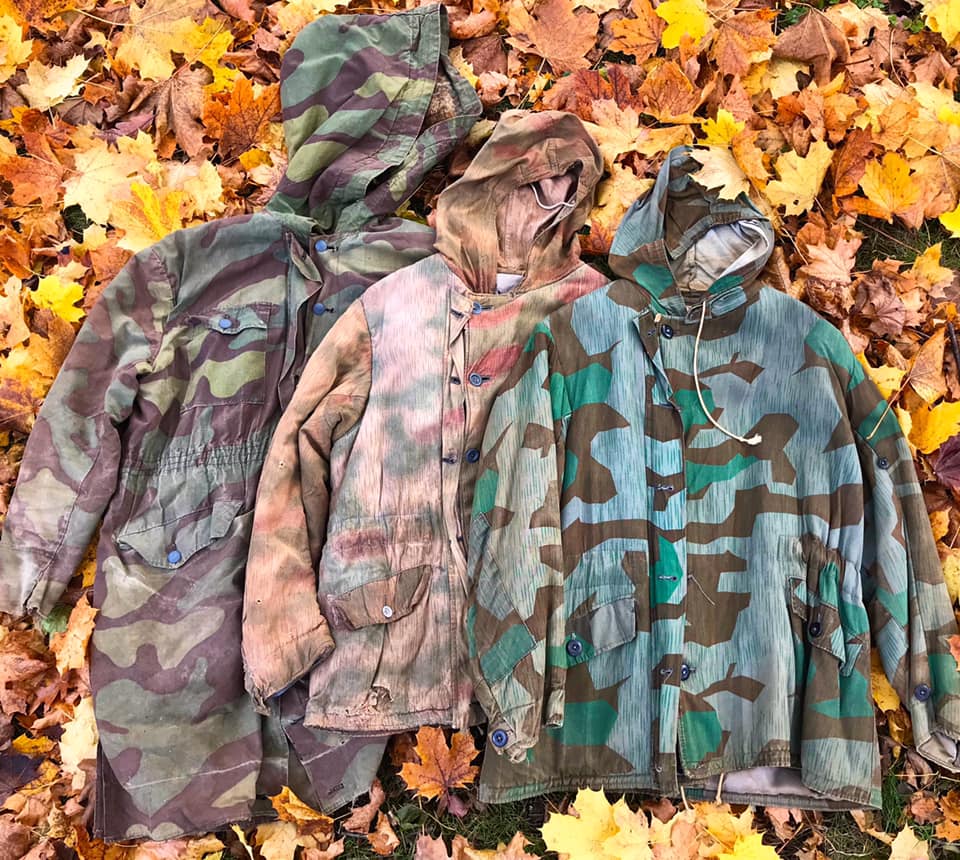
WWII German “Booby Traps”
Our impression is based on an isolated, rear area, security outpost. Essentially we are combat ineffective, and passive defense is all we have to offer. One means of soft protection is through the use of booby traps. These were commonly used by the Germans during WWII, especially when abandoning a position, in retreat, or as means of passive defense. This blog post is an introduction to WWII German booby traps.
Introduction: A booby trap is an explosive or non-explosive device or other material, deliberately placed to cause casualties when an apparently harmless object is disturbed, or a normally safe act is executed, or a normally safe place is occupied. They are not offensive weapons, and no battle, let alone war, can be won with booby traps. They are defensive weapons. They can provide early warning of a foe’s approach. Their main contribution is psychological, and a slowing of the enemy’s advance. For non-combat reenacting purposes, setting (non-active) booby traps is a very “zoney” experience for immersion settings.
Activation: Booby traps are activated by one of a few means. These are the most common forms of bobby trap activation.
Pull Release: A basic trip wire. An explosive charge is anchored, and wire is attached to some other object. A pull on the wire releases a firing pin in the explosive. These are mostly German stick and egg grenades (activated via trip wire).
Tension Release: When wire is cut, broken, or released
Pressure: Adding weight to an object
Pressure Release: Removing weight from an object
Lever Release: Fuse activated by pulling a safety/arming pin. An “enticing” object is placed on top of a grenade with the lever removed. The “enticing object” has just enough weight to keep the release lever in place. Once the object is moved, detonation occurs. Many Russian and Allied grenades were this style, and could be used in this fashion.
Placement: The Germans excelled at predicting enemy thought processes in order to develop unpredictable booby trap situations. One famous example involved a crooked painting on a wall. The Germans anticipated that only an anal retentive Officer would want to straighten a crooked wall hanging. They were correct. When an Allied Officer straightened the photo, movement of the picture frame activated a booby trap, and killed him. This illustrates that the key to placement is to think ahead, to anticipate how people interact with their environment, and to place traps that mesh with those actions. That said, there are some general principles that serve as guidelines to where, and how, booby traps should be placed and positioned.
Booby traps are most effective when used in small, confined, spaces. In such spaces there is a higher chance of activation, and greater explosion impact. Examples of such spaces are passages, stairways, doorways, smaller foxholes, narrow paths, etc. Items of curiosity are also great choices: souvenirs, containers, jewelry, food, water, gasoline containers, “abandoned” weapons, etc. Everyday operations can also be nefarious booby trap locations. Opening a window or door, flipping a switch, picking up a phone receiver, etc. The Germans booby trapped almost every conceivable area, and type of moveable object, with assorted prepared charges.
In Roadways
-Obstacles in road / near roadside (Very common. Some type of obstacle is placed in road. Log. Barrel. Vehicle. Anything. It is booby trapped to explode when moved. A field of fire can also be set up on the roadblock.)
-Embankments
-Blind bends
-Bridges
-Culverts
-Wooded stretches
-Junctions
-Crossroads
-General debris
-Shoulder of roads (sharp corners), where vehicles/foot solider may swerve off main road
-Near roadside houses or obvious turnouts, where vehicles are likely to pull over, or parking areas
-Entrance to detours
-Railroad crossings
In Open Country
-Woods
-Trees
-Low branches of brush
-Posts
-Gates
-Fences
-Paths
-Hedges
-Obstacles
-Stores
-Dumps
-General debris
-River fords/banks
In Buildings
-Steps
-Floors
-Doors
-Windows
-Cupboards
-Ovens
-Passages
-Furniture
-Fireplace
-Wood piles
-Water traps
-Closets
-Supplies
-Telephones
-Light switches
-Floor coverings
-Pictures
-Documents
-Debris
-Loose floor boards
-Rugs
-Flashlights
-Cigarette Cases
-Pens
Assorted
-Bodies of dead
-Soap
-Jerry Cans
-Food/Water
-Fishhooks hanging dark pathways (inside or out)
Use of Dummy Traps: Dummy booby traps (e.g. inactive) can effectively be used, especially if a few are “obviously” placed to ensure they will be found. Once they have been detected, the enemy will not know which traps are real, and which are inert. He will be extra cautious, and investigate/avoid all that looks suspicions, which will delay his advance. This can help create the illusion of a much stronger defense than is actually present, which can be greatly beneficial to thinly occupied areas. Multiple live, and dummy traps, can be placed in a concentrated area. Inaccurate signs can also be used to further create confusion (e.g. a sign indicting area is mined, when it fact it is not, or vice versa).
Detection: Of course, booby traps can also be used against your own forces, especially by partisans. Being acutely aware of your environment can aid in detection. Below is a list of things to watch for.
-Moveable objects: equipment, souvenirs, etc.
-Minor obstructions of all kinds on roads
-Be very suspicious at sabotage locations. Cut wires, road obstructions, blown bridges/tracks, etc., all which must be repaired are often booby trapped (esp. sites of cut communication lines).
-Inside trench systems, fox holes, in buildings, etc.
-Disturbed ground, esp. after rain
-Explosive wrappings, sawdust, nose caps from shells, etc.
-Traces of camouflage, withered vegetation
-Breaks or disturbances in vegetation, dust, paintwork, timbering, etc.
-Presence of pegs, nails, electric leads, pieces of wire or cord where there is no apparent use
-Marks on trees, paths, the ground, walls, etc. where there is no apparent reason
-Booby traps will not often be found in inaccessible places. If you make own trail, you will be safer.
-Irregular tracks of foot/wheels traffic where no apparent reason
-Any indication that an area has been carefully avoided
-Any indication of attempted concealment, or indication of all too obvious objects
-Anything out of the ordinary may indicate a booby trap
-Everything movable, seemingly harmless, and enticing should be treated with caution.
Avoidance: To avoid booby traps, avoid obvious actions (e.g. going through a doorway when there is another option, climbing over an obvious break in stone wall, etc.). These are prime locations for booby traps, as typical human behavior/actions are very predictable in such settings.
-Avoid obvious, well-used path ways
-Climb over low walls rather than use gates
-Check ditches and foxholes rather than just jumping in
-Enter buildings through blasted holes/windows rather than doors
-Be suspicious of anything enemy left behind
-Touch nothing that appears enticing
FUSES
Two of the most common fuses for booby traps were the Z.Z. 35 (pull activation) and the Z.u.Z.Z. 35 (pull and release activation). These can be used in conjunction with egg grenades, S-Mines, teller mines, box mines, and stock mines.
Eihandgranaten 39 (Eihgr. 39)(Egg grenades)
Der Rekruit, 1935
Handbook on German Military Forces, TM-E 30-451, March 1945
World War II Axis Booby Traps and Sabotage Tactics, Gordon L. Rottman
In der Heimat steh’n auf Posten
“Whatever moves a soldier’s innermost feelings most strongly, be it battle, victory, death, comradeship, loyalty, love of weaponry, love of homeland, love of wife and family, all these emotions find their immediate expression in the wealth of beautiful soldiers’ songs which have been handed down through many generations, and also in the great number of new songs which give expression to the experiences of the current war….” -Hauptmann Wilhelm Matthes, 1940
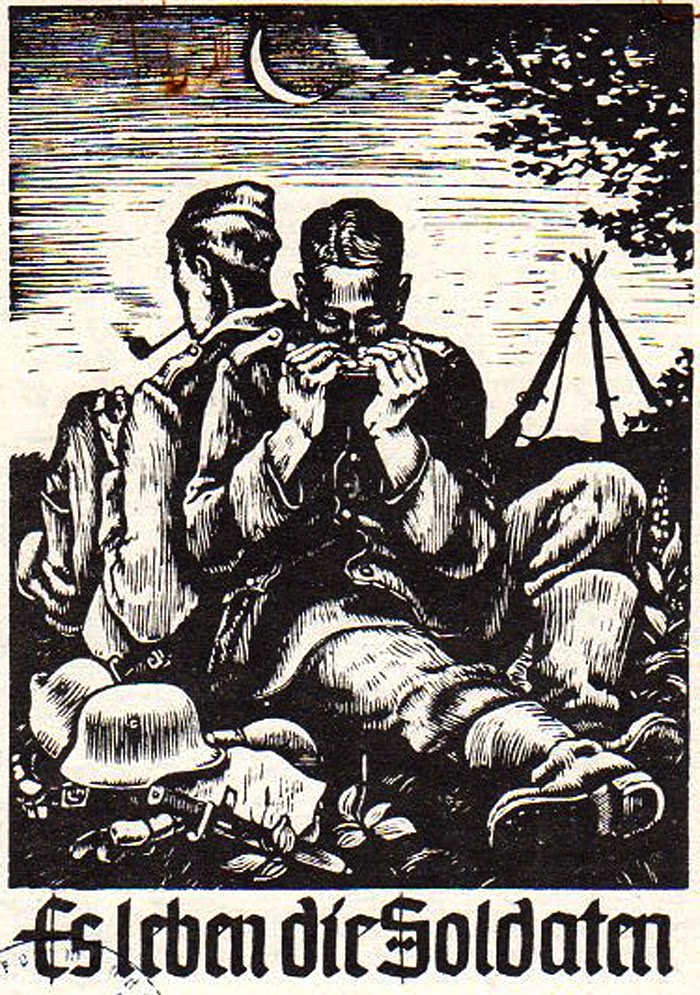
The singing of marching songs was an important part of the German military tradition inherited by the Wehrmacht. Many veteran memoirs mention fond memories of the songs sung as soldiers, both during training and while deployed to the field. Communal singing was part of the culture of the Landser, just as it had been for the Feldgrau in the first World War.
At events, our reenactment unit sings a variety of typical German songs from that era when we are on the march. Singing provides a cadence that helps to keep marchers in step. Some of the songs we sing are traditional folk songs, some are military songs that pre-date WWII and some were composed during the Third Reich. But our favorite song, the unit song of our reenactment group, is “In der Heimat steh’n auf Posten” or “Der Wachposten” (“In the homeland stand on sentry duty” or “The Guardsman”).
This song was composed in 1939 by Herms Niel, a famous composer of German marching songs who also wrote many well-known soldier’s songs from that time including “Erika” and “Sieg Heil – Viktoria.” This particular song is not as well-known but it suits our unit impression very well. No doubt, the song’s call to watchfulness and ideological appeals to a national community would have been familiar themes for German security troops in WWII.
Lyrics:
In der Heimat steh’n auf Posten
Straff in Süd, Nord, West und Osten
Alle Deutschen, jung und alt,
Alle Arbeitskameraden,
Bauern, Bürger und Soldaten,
Treu die Hände fest geballt.
Chorus: Für des Vaterlandes Ehr’
Mit dem Führer teilen wir
Mann und Mann
Und Hand in Hand
Für das deutsche Vaterland. (repeats)
In der Heimat heißt es schaffen
Nimmer wollen wir erschlaffen
Wollen treu zusammensteh’n
Mutig unsere Hände rühren
Und im gleichen Schritt marschieren
Für des Volkes Wohlergeh’n.
In der Heimat steh’n auf Posten
Straff in Süd, Nord, West und Osten
Alle Deutschen kampfbereit,
Trutzig wie einst uns’re Ahnen
Folgen heute wir den Fahnen
Der Idee von Jung und Alt.
Translation:
In the homeland stand on sentry duty
Tense in south, north, west and east
All Germans, young and old
All work comrades,
Farmers, civilians and soldiers,
Loyally the fists tightly clenched.
For the honor of the Vaterland,
With the Führer we take part
Man and man,
and hand in hand
for the German Vaterland.
In the homeland, they say handle it.
We are never going to let up
We want loyally to stand together
Bravely to move our hands
And march in step
For the well-being of our people.
In the homeland stand on sentry duty
Tense in south, north, west and east
All Germans are battle-ready,
Defiant as once were our ancestors
Today we follow the flag
The idea for young and old.
MG26(t) and MG30(t) Light Machine Gun
The ZB-26 light machine gun was developed in Czechoslovakia in the 1920s and used by the Czech military and also exported to other countries. Further development of the ZB-26 resulted in later versions including the ZB-30. A major customer of this latter model was Yugoslavia with 15,500 weapons bought. Romania (a later ally of Germany on the eastern front) also bought 17,131 of these ZB-30 machine guns. When Germany occupied Czechoslovakia in March 1939, the ZB-26 and ZB-30 were both incorporated into the Wehrmacht and Waffen-SS under the designations MG26(t) and MG30(t), the suffix (t) denominating a captured weapon of Czech (“tschechisch”) origin. Altogether, the Germans acquired 31,204 ZB-26 and ZB-30 machine guns at that time, some sources indicate that the majority of the captured guns were the ZB-30 model. 1,500 of these guns were sold to the German ally Bulgaria, the others were issued to the various Wehrmacht branches and also the Polizei and Waffen-SS. Later, when Germany occupied Yugoslavia, they also captured some of the 15,500 ZB-30 machine guns that had been sent there, although it is unknown how many of these exactly were captured. Production of these weapons was continued under German occupation in Czechoslovakia and 10,430 were produced for the Wehrmacht and SS in 1939 and 1940. These examples cannot technically be considered “captured” but were actual German production. In 1941 production was switched over to the MG 34 and production of the MG30(t) / ZB-30 ceased.
The Wehrmacht command issued a manual for these weapons.
Some photographs of these weapons in use with the German Heer.
We have researched what kinds of units this weapon was issued to and have found some evidence in the form of original Wehrpässe for soldiers who were trained on these guns. Here are some scans from a Wehrpass of a soldier who served in Landesschützen and construction units. At one time his job was guarding POW camps. He was trained on the MG26(t).
Other documents from other sources show the Czech light machine guns issued to soldiers in similar units. A Wehrpass for a soldier who was part of the occupation forces in the Netherlands, performing security duties as part of Sicherungs-Regiment 26, was trained on the “le. M.G. (t),” this could have been either a 26 or a 30. Further evidence for the use of these weapons in Sicherung units was found in a Wehrpass issued to a soldier who served in Landesschützen-Bataillon 638 (part of Sicherungs-Regiment 285) who took part in the campaign in Russia from August 1941 until February 1942 when he was grievously wounded. Other rear-line and garrison type units also used this weapon in occupied areas. A Wehrpass to a soldier assigned duty securing the coast of the Atlantic and English Channel in France shows training on Czech weapons including the MG26(t) (listed as l. M.G. 26 (Bruenn), for the place where it was made), a Czech pistol and a Czech Pak cannon. German records for the island of Jersey in the English Channel show 4 x MG26(t) as part of the ‘pool’ of weapons for the 319. Inf. Div. stationed there. There were also 500 x MG34 and 200 x MG42 plus 200 other mixed MG types of mainly French origin.
The use of Czech and other captured, obsolete and reissued weapons in rear-line units was widespread. The following weapons were recorded in use by Sicherungs-Brigade 203 on the Eastern Front as of June 1, 1942:
German K98k rifles: 3.123
Polish, Czech, Yugoslavian rifles: 2.650
French and Dutch rifles: 811
Russian rifles: 1.110
Pistols: 929
Submachine guns (MP 38): 43
MG 08/15: 137
MG 34: 6
MG26(t) and MG30(t): 178
Russian machine guns: 73
MG08 heavy machine guns: 5
Russian heavy machine guns: 85
Russian light mortars: 87
Russian heavy mortars: 28
Anti-tank rifles: 4
Russian anti-tank cannons: 8
Note that in this particular Sicherung unit, Czech machine guns greatly outnumbered the German MG34. Original Soldbücher that we have examined show that captured weapons like those in the above list were still being issued on a wide scale to rear-area support troops until the end of the war.
Sicherungs-Regiment has a ZB30 that we use to represent the MG30(t) in our displays and living history vignettes. It’s an original weapon that has been demilitarized and deactivated. Since we are a rear-area unit, many of the scenarios we create do not involve firing weapons, so this dummy gun works just fine. The captured and obsolete weapons we use enhance our impression of Sicherung troops.


















